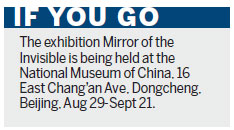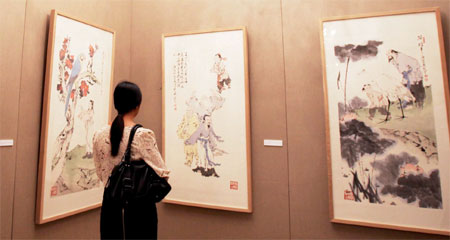Fan Zeng, mirror of the invisible
Updated: 2014-08-22 10:15
By David Gosset(China Daily Europe)
|
|||||||||||
|
A visitor appreciates Fan Zeng's artworks in Paris. Gao Jing / Xinhua |

The poet and painter projects the harmony of East and West, the past and the future
The vicissitudes of history have never really interrupted the life of Chinese art. In the era of a dematerialized cyberspace the Four Treasures of the Study (wen fang si bao) - brush, ink, paper and the ink stone - continue to inspire, and China's 21st century renaissance is giving a new meaning to the course of the black liquid.
Less obsessed by avant-garde experiences or disruptive newness than concerned by inheritance and harmony, the art of Fan Zeng is one of the most significant variations on the classical themes of Chinese civilization.
Praised by Li Keran (1907-89) for his technical mastery, Fan, born in 1938 and descended from 13 generations of scholars, has imposed his mark on poetry, painting and calligraphy, the literati's traditional domains of artistic expression.
His writings are widely known, and this year the opera tenor Liao Changyong is on tour interpreting Fan's poems arranged for orchestral accompaniment by the country's greatest composers.
Fan's paintings, his famous Zhong Kui, his representations of Laozi and his depictions of old masters passing knowledge to future generations are collected by connoisseurs in China, the rest of Asia and beyond.
Since the end of the 1980s he has lived between Paris and Beijing, and his portrait of Charles De Gaulle, a symbol of friendship between France and China, stands in the office of French Foreign Minister Laurent Fabius near the River Seine as the two countries commemorate the 50th anniversary of their diplomatic relations.
The poet and painter Fan is also a prince in the realm of Chinese characters, and, approaching his calligraphies as if they were Western sculptures, it could be said that he dominates the logograms as Phidias, Michelangelo and Rodin mastered their marble.
In the master's world of the brush, the purity of the lines is obvious, the most complex climates, moods or emotions are expressed by the simplest forms, but his style is also defined by a rare sprezzatura, or effortless virtuosity and brilliance, a subtle quality that was highly appreciated during the Italian Renaissance. In his greatest realizations, Fan's sprezzatura echoes the divine refinement of Raphael.
While run-of-the-mill artists display only their artistic talents, Fan, in a sense, hides his art. In other words, his art is non-art as much as the Tao's most perfect action is non-action, but this supreme sprezzatura should not be mistaken for minimalism in which the effort of subtraction is strikingly visible. Laborious manners and minimalist shows equally differ from the grace of ethereal sprezzatura.
In Fan's splashed ink (po mo), spontaneous execution agitates the brush, all is happening, in the words of the master, in "the blinking of an eye, swiftly, as the falcon swoops down or the hare starts out".
But such an easiness of movement in a flash does presuppose the most accomplished craftsmanship. It is the crystallized tradition in the master's mind and body that explodes in lines and curves on paper, the most rigorous practice and discipline culminating in the freedom of improvisation.
In his masterpieces, Fan's biography, erudition, sense of humor and remarkable physical presence have disappeared, the Four Treasures of the Study have vanished, only qi, vital energy, circulates between the visible and the invisible.
The master does not have the ambition to be in a position of a transcendent creator; he only hopes to capture the rhythm of immanent transformations. He does not wish to emulate God and the genesis; he has retracted his ego from the world to better follow preexisting patterns of change and express the music of Heaven and of Earth.

Let us contemplate once again Fan's Zhuangzi and the Butterfly, a powerful composition inspired by a famous story of the Taoist philosopher Zhuangzi (369-286 BC): "Once Zhuang Zhou dreamt he was a butterfly, a butterfly flitting and fluttering around, happy with himself and doing as he pleased. He did not know he was Zhuang Zhou. Suddenly he woke up and there he was, solid and unmistakably Zhuang Zhou. But he did not know whether it was Zhuang Zhou who had dreamt he was a butterfly, or a butterfly dreaming he was Zhuang Zhou. Between Zhuang Zhou and a butterfly there must be some distinction. This is called the transformation of things."
In Zhuangzi and the Butterfly, neither the thinker nor his vision dominates the scene; there is no sign of dualism between reality and imagination but only the dynamic presence of their eternal relation.
Fashions, categorizations or the latest aesthetic discourses do not alter Fan's serenity, when, at 76, he handles the brush. He simply reinterprets Chinese classical themes, and by reconnecting with Wang Xizhi (303-361) and Bada Shanren (1626-1705) he lives, stronger than ever, full of the life of Chinese art.
Would there be more beauty in the reinvention of the tradition than in the modern or post-modern quest for vanguardism? The answer is in the mature simplicity of the master's forms and the universal emotion it generates.
An old man with the soul of a child, Fan does not oppose the past and the future, East and West, permanency and change; he projects their eternal harmony.
His visualization of the invisible, which reconciles the opposites, is the representation of wisdom.
The author is director of the Academia Sinica Europaea at China Europe International Business School, Shanghai, Beijing & Accra; and founder of the Euro-China Forum. The views do not necessarily reflect those of China Daily.
(China Daily European Weekly 08/22/2014 page14)
Today's Top News
Telegram good gesture from Pope to China
Japanese firms face $200m fine
Ice Bucket Challenge hits China
Gaza ceasefire talks collapsed
Heinz recalls four batches of infant food in China
WHO says Ebola has killed more than 1,200
Japan looking to buy more stealth fighters
2 Air Force jets collide in Italy, 4 airmen missing
Hot Topics
Lunar probe , China growth forecasts, Emission rules get tougher, China seen through 'colored lens', International board,
Editor's Picks

|

|

|

|

|

|






